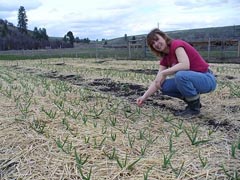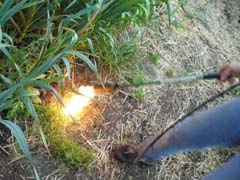Summary
Effectiveness and economic impact of weed control systems in organic garlic production
Investigator and project location: Susan Fluegel, Grey Duck Garlic, Moscow, Idaho
Organic gourmet hardneck garlic is an excellent niche market, high value crop that can be profitably grown on a few acres. Demand for organic gourmet garlic is growing and the supply cannot keep up with the demand. As a result, interest in garlic production is increasing.Organic hardneck garlic is extremely labor intensive, and the most labor intensive aspect of organic garlic growing is weeding. Even moderate weed coverage can severely reduce garlic yield and bulb size. Since garlic is a nine month crop the organic farmer must combat multiple flushes of weeds.
To help organic farmers choose suitable weed control, Susan Fluegel and her partners at Grey Duck Garlic Farm evaluated the effectiveness of four different weeding methods on two varieties of organic hardneck garlic, German Red and Georgian Crystal.
Pre-planting weed control included solarization or stale seedbed technique. Solarization used plastic placed over the crop bed to heat up the soil and kill weed seedlings and seeds. Stale seedbed technique used repeated shallow cultivation before planting to destroy emerging weeds.
Post-planting weed control compared hand weeding with flame weeding.
The two main treatments were pre-planting solarization and stale seedbed. The subplots were garlic variety, German Red (GR) or Georgian Crystal (GC) and weeding method (flame or hand). Each of the larger main plots contained four randomized subplots: GR flame weeded, GR hand weeded, GC flame weeded or GC hand weeded.To determine the effectiveness of each combination of pre- and post-planting weeding methods, Susan evaluated weeding time, weed coverage, garlic bulb weight (total yield), garlic bulb size, and the economic feasibility for all weed control methods.


